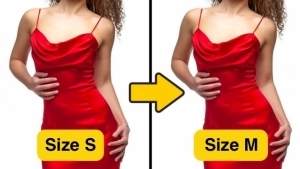9 secrets of clothing stores that sales associates will never tell you
Clothing manufacturers have all the tricks. From fake sales to inflated prices, to misleading displays and manipulated sizes, not to mention the strategic ways stores are decorated to attract customers and then lead them to the most profitable items. Here are some of their secrets that make you have less.

1. Sales benefit the stores, not the customers

(C) depositphotos (C) depositphotos
Have you ever wondered how the store could make a profit off of you when you buy something at full price, if it can sell you the same item at 10, 20, or 70% off later in the season? It makes you think...
Among stores’ other tricks, there may be an artificial price increase just before a sale (so you may have managed to get 20% off, but the price had been increased by 30%...you do the math).
Besides, we know that the sales have the goal of attracting customers to the store with irresistible offers, in order to offer them other items for full price at the same time. Although the merchant is honest, the special offer really exists and you get a good deal on it, but sometimes you not only leave with things you didn’t originally need, but you also didn’t find what you came there to buy!
2. Clothing sizes are not consistent

Don’t think you've gained 2 sizes since last week! Clothes sizes differ drastically from one brand to another, because they aren’t sized according to a standard measure adopted by everyone, but rather according to what the manufacturer decides. There are different reasons for changing the size scales: saving fabric, pleasing a customer who is happy to buy a “small,” when she’s actually one or two sizes larger, forcing customers who buy things without trying them on to return to the store to exchange them (and therefore be tempted to buy something else), etc. They may also raise the prices of large sizes (while they are actually average sizes cut too small). They use all kinds of tactics.
3. A big name does not always mean high quality

Larger stores sometimes collaborate with well-known designers, but that doesn’t mean that you get a haute couture piece of clothing! In fact, the design may be special, but in general, the big names have the mission of creating a cheap article, so they don’t take the time to create a masterpiece. They also use cheap materials to keep the cost down, so the store can recover the outrageous amount requested by the star designer.
4. The sale section is intentionally left a mess

The sale section hasn’t been torn apart by a horde of wild buyers as they make you believe. This messy condition has two purposes: you have to search through the entire collection of clothes to tempt you to buy more clothes, and to make you believe that you have found "THE" rare item (you are exceptional!). They make you feel like you have to buy something immediately before anyone else finds it.
5. Clothing by large retailers contains harmful chemical products

(C) depositphotos (C) depositphotos
Don’t rely on the "100% natural" label, which can be misleading. Manufacturing and storing clothing requires the use of powerful chemicals that do not appear on labels. Some chemicals are needed to obtain a certain color or texture, while others are used to protect the fabrics from insects and mold. One tip: always wash clothes before wearing them for the first time, especially clothing for young children, who are more sensitive.
6. Synthetics cost as much as natural fibers

(C) depositphotos (C) depositphotos
Clothing manufacturers tend to increase the prices of synthetic items to encourage customers to buy more expensive clothes made from natural materials. Customers think that a cotton or wool top is not so expensive compared to synthetic ones, and they buy them without thinking.
7. Brand-name clothes from factory outlets are not as good quality as those from retailers of the same name

(C) depositphotos (C) depositphotos
Just like for TVs: a piece of clothing from Brand X (known for its reliability and quality) is not made at all with the same materials, as it is intended for a discount store or a factory outlet. You think you’re buying the same brand, but in truth you are buying a lower line that just has the same design. Luxury brands have developed this system in order to be able to get money from the general public, which spends less but in greater numbers.
8. Clothing is not made to last

Just like appliances that don’t last forever, our clothes are designed to not be durable, so they are sewn poorly, the images are printed with low quality, the material doesn’t last, the colors fade... This allows the manufacturer to waste less time designing the garment, but it especially forces us to replace our clothes more often, and every time we buy more than we expect to, so we multiply their profits!
9. Fashion trends change all the time

(C) depositphotos (C) depositphotos
There was a time when we bought clothes whenever the weather (or our size!) changed: in spring and fall. Nowadays, there are a lot more “seasons,” and fashion trends change a lot more often. Stores no longer have two arrivals a year, but one every week, making us want to visit the shops more often so we won’t miss out on something special.
Photo credits: depositphotos
Source: BrightSide

By Straker Julia
Writer
Passionate about writing, I write articles on the subjects that I love. Creativity and Animals themes are my favorites!


